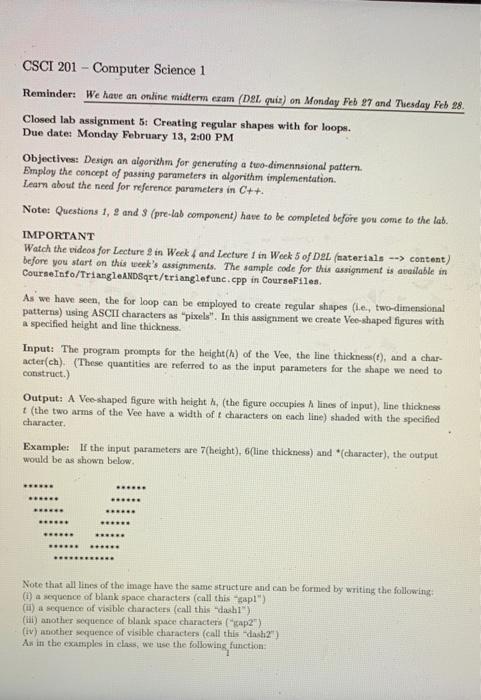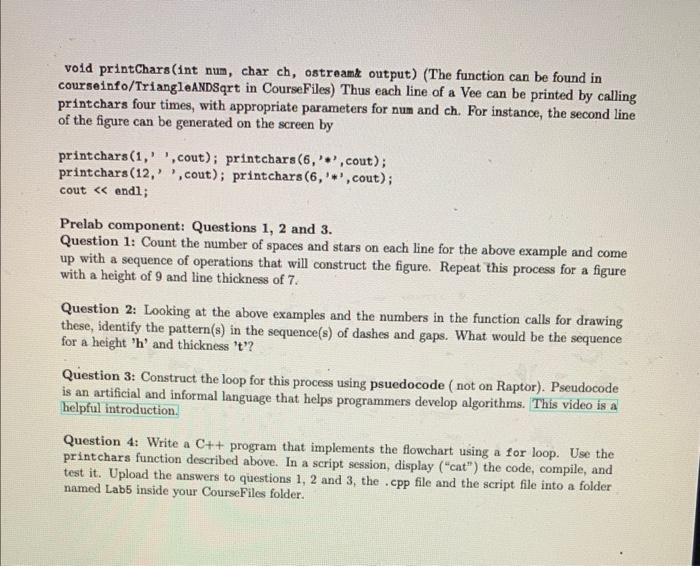CSCI 201 - Computer Science 1 Reminder: We have an online midterm exam (D2L quiz) on Monday Feb Due date: Monday February 13, 2:00 PM Objectives: Derign an algorithm for generating a two-dimennsional pattem. Employ the conoept of passing parameters in algorithm implementation. Leam about the need for neference panameters in C++. Note: Questions-1, 2 and $ (pre-lab component) hate to be completed before you come to the lab. IMPORTANT Wotch the eideos for Lecture 2 in Week 4 and Lecture I in Week 5 of D2L (naterials content) before you atart on this week's assignments. The sample code for this assignment is availabile in Courseinfo/TrlangleANDSqrt/trianglefunc, cpp in CourseFiles. As we have seen, the for loop can be employed to create regular shapes (i.e., two-dimensional patterns) using ASCII characters as "pixels". In this assignment we create Veeshaped figures with a specified height and line thickness. Input: The program prompts for the beight (h) of the Vee, the line thickness(t), and a character(ch). (These quantities are referred to as the input parameten for the shape we need to construct.) Output: A Vee-shaped figure with height h, (the figure occupies h lines of input), line thicknes t (the two arms of the Vee have a width of t characters on each line) shaded with the specified character. Example: If the input parameters are 7(height), 6 (line thickness) and *(character), the output would be as shown below. Note that all lines of the image have the same structure and can be formed by writing the following: (i) a icquence of blank space characters (call this "qup1") (ii) a sequence of visible chatacters (call this -datht') (iii) another sequence of blank space characters ( "Eap2") (iv) asother seguence of visible characters (call this -davi2") As in the exatmplesi in class, we use the following, function: void printChars (int num, char ch, ostreams output) (The function can be found in courseinfo/TriangleANDSqrt in CourseFiles) Thus each line of a Vee can be printed by calling printchars four times, with appropriate parameters for num and ch. For instance, the second line of the figure can be generated on the screen by printchars (1,' ', cout); printchars (6,, , cout); printchars (12,' ', cout); printchars (6,, cout); cout endl; Prelab component: Questions 1,2 and 3. Question 1: Count the number of spaces and stars on each line for the above example and come up with a sequence of operations that will construct the figure. Repeat this process for a figure with a height of 9 and line thickness of 7 . Question 2: Looking at the above examples and the numbers in the function calls for drawing these, identify the pattern(s) in the sequence(s) of dashes and gaps. What would be the sequence for a height ' h ' and thickness ' t '? Question 3: Construct the loop for this process using psuedocode (not on Raptor). Pseudocode is an artificial and informal language that helps programmers develop algorithms. This video is a helpful introduction. Question 4: Write a C++ program that implements the flowchart using a for loop. Use the printchars function described above. In a script session, display ("cat") the code, compile, and test it. Upload the answers to questions 1,2 and 3, the .cpp file and the script file into a folder named Lab5 inside your CourseFiles folder








